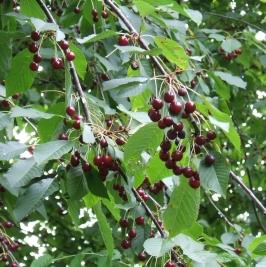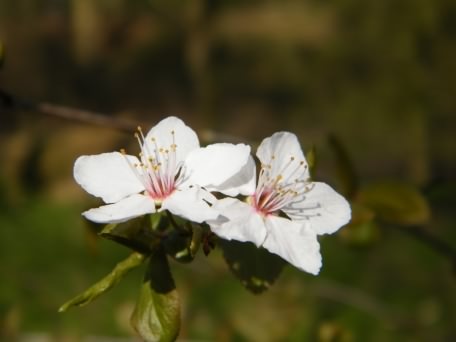
Photo ©2006 MPF
Click any photo for a larger image

Photo ©2012–


Photo ©2006 MPF
Click any photo for a larger image

Photo ©2012–
Wild Cherry - Prunus avium
Family - Rosaceae
Also known as - Sweet or Mazzard cherry
Parts of this plant are poisonous.
Wild Cherry is a small deciduous tree with round red fruit, sometimes grown for its reddish brown timber which is used for turnery products, furniture, veneers, decorative paneling and pipes. Good firewood with fragrance of blossom as burns. Grows to a height 9m (30ft) attaining an age of up to 200 years. Found in woods and hedgerows throughout the British Isles and most of Europe except Northern Scotland, cultivated in gardens usually for the profusion of spring flowers. Prefers non acidic rich soils, growing usually from seed but can be grown from cuttings when taken from young trees.
Cultivated cherries are derived from Prunus avium. Mid green leaves are elliptical in shape tapering to point, 5–12cm (2–5in) long, simple alternate with a doubly serrulate edge, on long stalks and having two small glands at base of the blade. In the autumn they turn to various hues of orange, crimson and purple. White flowers in hanging rounded clusters of up to six flowers usually appearing in April, fruiting to a fleshy, yellow or red berry with a large pit or stone 1–3cm (0.5–1.2in) in diameter. Plant originated in Eurasia.
There are many cultivars and imported relatives, some with very large, showy blossoms and others producing very good cherries for eating. The Latin name is derived from Prunus or plum and avium, from the Latin "avis" or bird who feast on the ripe fruit. The Prunus genus has about 400 species, most of them native to the Northern Hemisphere. Two species of cherry are native to Britain, the Wild Cherry having a high timber value is fast growing. The second, Bird Cherry – Prunus padus is smaller, doing best on wetter acid soils. Wild cherry has a distinctive smooth bark, reddish or purple–brown in colour with a metallic copper sheen. It is punctuated with large lenticels or breathing pores in bands around the trunk which often peel in small thin strips.
In the wild, root suckers often develop around mature trees and eventually grow as large as the parents, forming clumps or small woodlands. Increasingly planted as a timber tree, it is easy to establish and for a broad leaved tree it has a relatively short rotation or growing life and may become senile by 60. Cherries are prone to bacterial canker where stem and branch wounds may exude a clear, protective gum reminiscent of resin in conifers but without the smell. Cherries grown for fruit are derived from two species, P. avium for its sweetness and P. cerasus the more acid Morello variety. Eating varieties are usually grafted onto wild cherry root stocks.
BCP do not advise or recommend that Wild Cherry – Prunus avium is eaten or used as an herbal remedy. The fruit is edible both raw and cooked, but the leaves, twigs and seeds are highly poisonous yielding cyanogenic glycoside which can lead to spasms, convulsions and respiratory failure. Birds find the fruit especially palatable quickly stripping whole trees of their fruit.
Site design ©1999– Brickfields Country Park - Privacy -